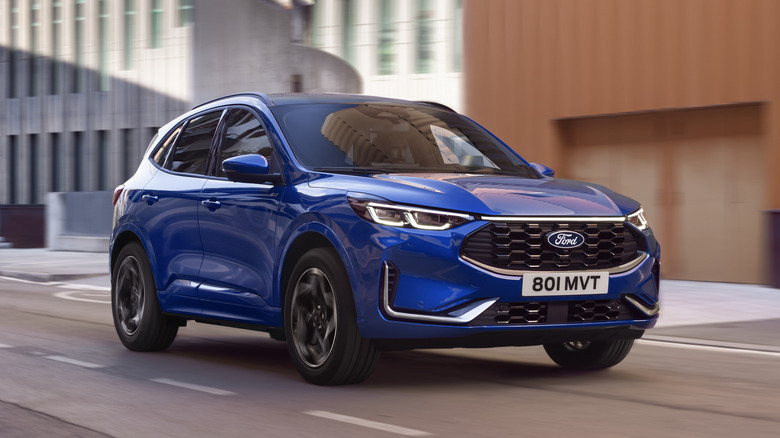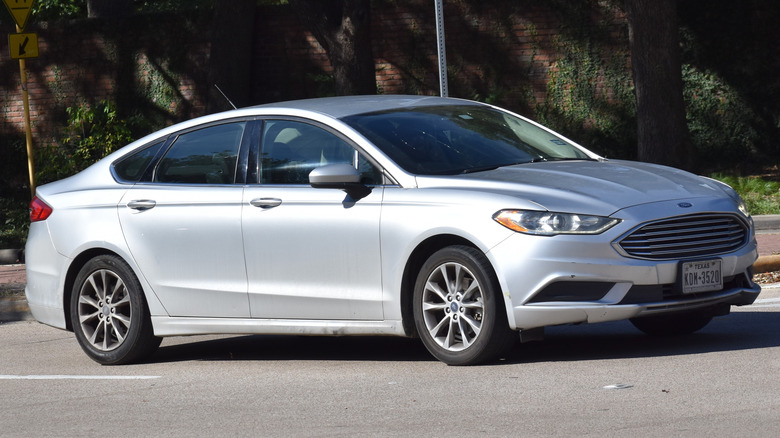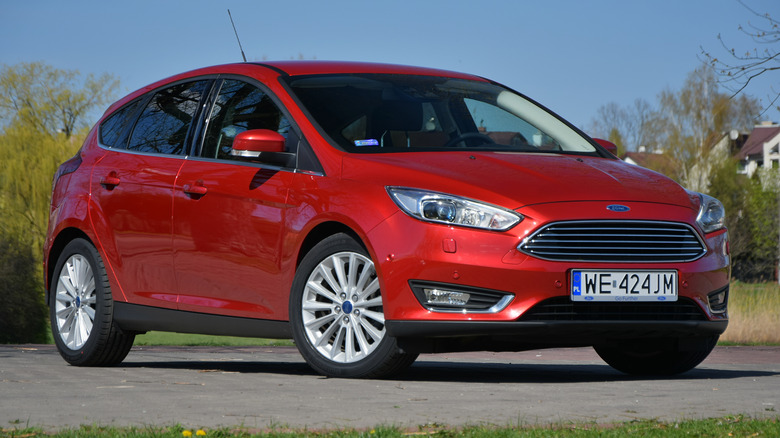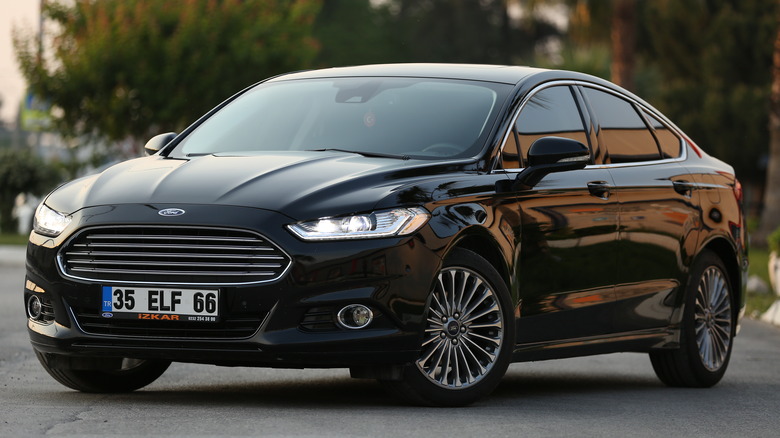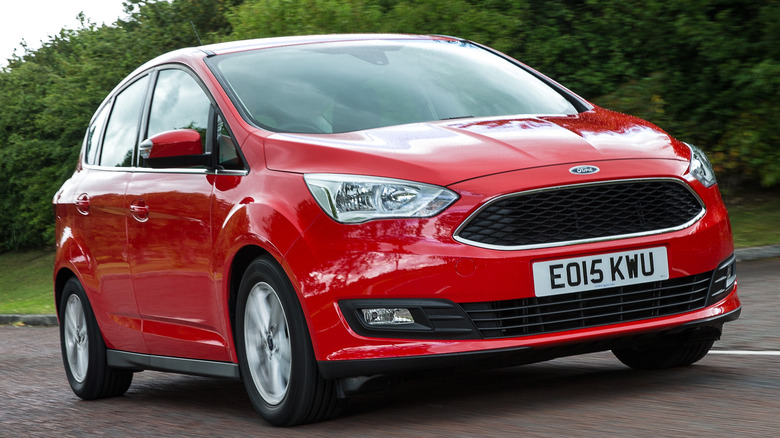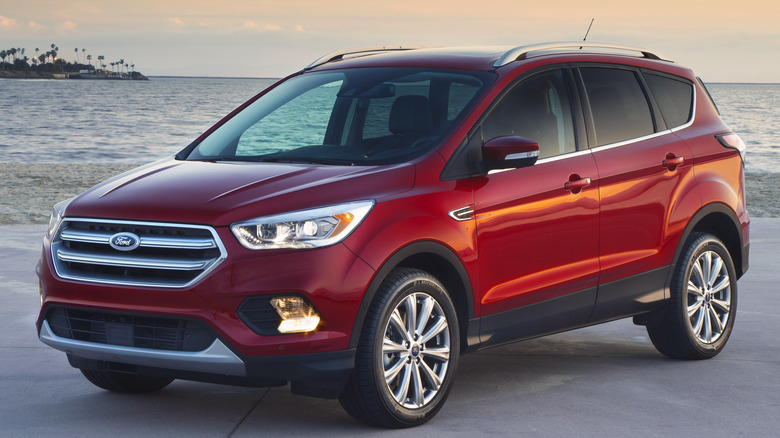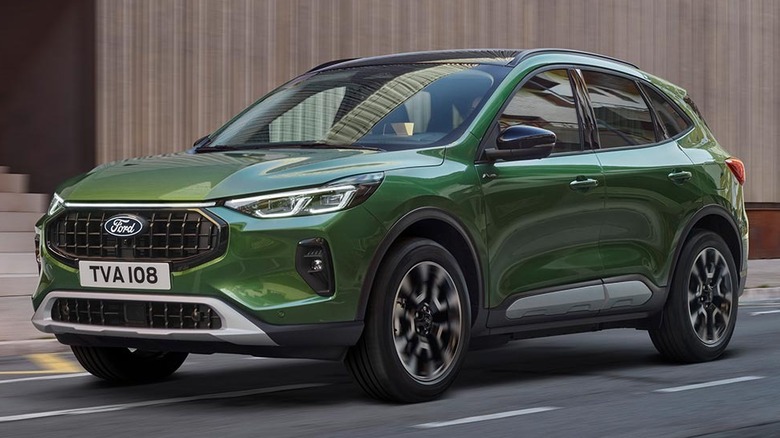Every Ford Model Built With The 1.5L EcoBoost I-4 Engine
The Ford Motor Company first introduced its EcoBoost engine technology to the world in 2008, aiming to improve fuel economy for vehicles across all its active brands — namely Ford, Lincoln, and Mercury. The first-ever EcoBoost engine was a twin-turbocharged V6, which debuted in the 2009 Lincoln MKS. The V6 made 355 hp and 350 lb-ft of torque, living up to Ford's claims of V8 power with V6 fuel economy.
The company quickly followed the V6 with two four-cylinder engines — a 1.6-liter and a 2.0-liter — in 2009, both of which would enter production the following year. Ford didn't stop there, though, and announced a 1.5-liter EcoBoost engine a few years later. The 1.5-liter was a downsized 1.6-liter EcoBoost, primarily motivated by the Chinese market. In 2006, the Chinese government changed its vehicle tax brackets so that owners who purchased cars with sub-1.5-liter engines like the 1.5-liter EcoBoost would only be taxed 3% (versus 5% on a 1.6-liter EcoBoost). Ford would also get a tax break on cars equipped with the 1.5-liter, making it a win-win for all involved.
Ford's 1.5-liter EcoBoost was only offered in a small handful of cars during the second half of the 2010s. It wasn't all that great an engine, either, ranking as one of the worst Ford EcoBoost engines ever made. But if you're curious, here's the list of all the Fords that came with the 1.5-liter, inline-four EcoBoost.
Ford Fusion (2014 - 2020)
Ford unveiled the second iteration of its Fusion sedan in 2012 ahead of its launch for the 2013 model year, an update that would also see it make its way to the rest of the world as the new Mondeo. The refreshed four-door car debuted in the U.S. with four engine options: 1.6- and 2.0-liter EcoBoost engines, a 2.5-liter non-EcoBoost inline-four, and a 2.0-liter hybrid inline-four.
The powers that be at Ford decided to add the 1.5-liter EcoBoost starting the next year, making it one of the few times Ford offered the engine in the U.S. The four-cylinder made 181 hp and 185 lb-ft of torque, offering more power and better fuel economy than the base 2.5-liter engine. 2016 saw the 1.5-liter EcoBoost fully replace the 1.6-liter model, which wasn't surprising given the near-identical power output and fuel economy ratings. Reviewers weren't entirely thrilled by the 1.5-liter in the Fusion, but its family sedan status meant that its mediocre performance wasn't necessarily a huge drawback.
The 1.5-liter EcoBoost was only available on the SE and Titanium trim levels, and buyers of the base model Fusion S had to live with the older 2.5-liter inline-four. But Ford wasn't done messing with the Fusion's engine options, and introduced the V6 Sport Fusion in 2017. This 325-hp sedan featured the 2.7-liter EcoBoost engine, which would be the final new gasoline engine Ford introduced to the Fusion during its lifetime.
Ford discontinued the Fusion in 2020, citing shifting customer tastes.
Ford Focus (2015 - 2020)
Ford's third-generation Focus debuted worldwide in 2011 with a range of Duratec and Duratorq petrol and diesel engines, before Ford introduced the 1.6-liter EcoBoost inline-four to the international market Focus in 2012. The U.S. Focus would only get an EcoBoost in 2013, in the form of the high-performance 2.0-liter EcoBoost.
A mid-generation refresh came in 2014, with updated looks, interiors, and engine options. The new European Focus retained the 1.6-liter Duratec engine it had debuted with but was also available with 1.0- and 1.5-liter EcoBoost inline-four engines as buyers moved up the trim levels. Ford reserved the 1.5-liter EcoBoost for the three highest trim levels: Zetec S and Titanium owners got a 148-hp version of the 1.5-liter four-cylinder, while those who ponied up for the Titanium X trim level could enjoy a 180-hp version of the engine. Both versions produced 177 lb-ft of torque.
The 1.5-liter EcoBoost was also available in the refreshed Focus for the Asia-Pacific region, albeit only in 180-hp form Ford didn't bring the 1.5-liter engine to the U.S., opting for 1.0- and 2.0-liter EcoBoost engines instead.
Ford retained the 1.5-liter EcoBoost throughout the rest of the third generation and partway into the fourth, where it was one of a dizzying array of engine options available. However the company revamped the Focus' engine options in 2021, opting for mild hybrid 1.0-liter EcoBoost engines for all but the Focus ST, which came with the 2.3-liter EcoBoost engine.
Ford Mondeo (2015 - 2018)
Of all the Ford nameplates on this list, the Mondeo is the oldest of them all. Launched in 1993 as a replacement for the Sierra, the Mondeo — available in both sedan and wagon body styles — was a fixture in Ford's worldwide product lineup for the better part of 30 years before finally succumbing to the worldwide shift toward SUVs, with Ford finally discontinuing the nameplate in 2022.
Like all of Ford's cars, the Mondeo played host to a selection of EcoBoost engines during the 2010s. The first one to feature in the Mondeo was the 2.0-liter EcoBoost, which Ford introduced in 2010. 2012 saw the debut of the 158-hp 1.6-liter EcoBoost, which became the Mondeo's only EcoBoost engine option when Ford stopped offering the 2.0-liter engine the following year.
Ford introduced a new Mondeo in 2014, which was essentially a rebadged Ford Fusion. However, Ford offered a different range of powerplants in the international-market Mondeo, ditching the old 2.5-liter Duratec inline-four of the base Fusion S for an all-EcoBoost selection — including the 1.5-liter inline-four EcoBoost, this time in its 158-hp form. Ford bumped the EcoBoost's power to 162 hp for 2018 before switching to hybrid and diesel EcoBlue engines in 2019. This engine lineup remained until Ford killed the Mondeo in Europe.
But Ford wasn't quite done with the Mondeo and launched a China-only fifth generation that same year. The new Mondeo debuted with a 2.0-liter EcoBoost under the hood, which Ford followed with a 188-hp four-cylinder 1.5-liter EcoBoost in 2024. However, it's unclear if this is the same 1.5-liter EcoBoost we all know and — don't quite — love.
Ford C-Max (2015 - 2019)
Ford's C-Max was a compact SUV and another Ford model with vastly differing powertrain options in the U.S and Europe. The C-Max first debuted as the Focus C-Max for the European market in 2003, before Ford dropped the Focus name in a mid-generation refresh. These early C-Maxes sported Duratec engines, but Ford introduced the 1.6-liter EcoBoost when it launched the second-generation C-Max in 2011.
The 1.0-liter EcoBoost joined its 1.6-liter sibling for the 2013 model year. Both engines were available in two versions, with the primary difference being the rated horsepower outputs. For example, Ford offered the 1.0-liter engine with either 98 hp or 123 hp. Ford also finally launched the C-Max in the U.S. in 2013, although the American C-Max was only available as a hybrid.
As with its other cars, Ford eventually replaced the 1.6-liter EcoBoost with the 1.5-liter version. Ford introduced the new EcoBoost to the C-Max in 2015 in 148-hp and 180-hp guises, although availability seems to have been somewhat inconsistent. German catalogs for the 2016 model year, for example, show both engines available as options, while the equivalent Spanish catalog only features the lower-power version of the engine.
Either way, the EcoBoost-powered C-Max would remain a Europe-only affair for the rest of its production run. A struggling European car market pushed Ford to restructure its European operations in 2019, which involved discontinuing cars like the C-Max and cutting 12,000 jobs.
Ford Escape (2017 - 2019)
The second-generation Ford Escape debuted at the 2011 Los Angeles Auto Show for the 2013 model year. Rebadged as the Kuga for Europe, the Escape was something of a hit when it made its way to reviewers, especially when equipped with the 240-hp, 2.0-liter EcoBoost inline-four engine available in the highest-end Titanium trim. The Escape sold well, but Ford didn't rest on its laurels and unveiled a mid-generation refresh at the 2015 Los Angeles Auto Show.
Ford's updated 2017 Escape featured several changes, most notably a couple of new engine options: the 1.5-liter EcoBoost — making 179 hp and 177 lb-ft of torque — and an updated 2.0-liter EcoBoost with 245 hp and 275 lb-ft of torque. Ford retained the older 2.5-liter iVCT inline-four, serving as the standard engine for the base-model Escape S.
The 1.5-liter EcoBoost was the standard engine for both SE and Titanium trim levels, with the 2.0-liter EcoBoost available as an option for both higher-end trim levels. An optional four-wheel drive system was also available on the latter two trim levels. Reviewers were somewhat disappointed by the 1.5-liter EcoBoost in the Escape, citing sub-par performance compared to rivals and surprisingly poor fuel economy. The years haven't been all that kind to the SUV either, with the Escape proving to be a compact SUV well worth avoiding on the used market.
Ford unveiled an all-new Escape in 2020, with a new engine lineup to go with it. Owners could still get a 1.5-liter EcoBoost in the 2020 Escape, but this would be an inline-three engine.
Ford Kuga (2014 - present)
The Kuga crossover debuted in the European market in 2007 as an example of Ford's then-new kinetic design philosophy. Available with two 2.0-liter diesels or a 2.5-liter turbo petrol engine, the first-generation Kuga stayed in Europe, despite rumors that Ford would bring the model over to the U.S.
However, when the second generation of the compact SUV debuted at the 2012 Geneva Auto Salon, it became clear that instead of bringing the Kuga to the U.S., Ford was bringing the Escape to Europe. The new Kuga was a rebadged Escape, and featured EcoBoost power right out of the gate — despite launching before the Escape's own EcoBoost refresh — with the 1.6-liter EcoBoost available in 148 hp and 177 hp forms for 2013. The engine options stayed unchanged for 2014, but Ford would eventually replace the 1.6-liter EcoBoost with its 1.5-liter brother for 2015.
The 2015 Kuga was available with 147-hp and 180-hp versions of the 1.5-liter inline-four, with the latter only available with four-wheel drive. Unlike Ford's other 1.5-liter EcoBoost cars, the Kuga would eventually be available with three versions of the engine after Ford introduced a lower-power 118-hp take on the inline-four in 2016.
The Kuga also differs from its American counterpart in that it's still available. The plucky 1.5-liter EcoBoost is still present as the base — and only — petrol engine. The 148-horsepower inline-four now competes for buyers' hearts against full hybrid and plug-in hybrid powertrains, both of which replaced the Kuga's Duratorq diesel engines in 2021.
